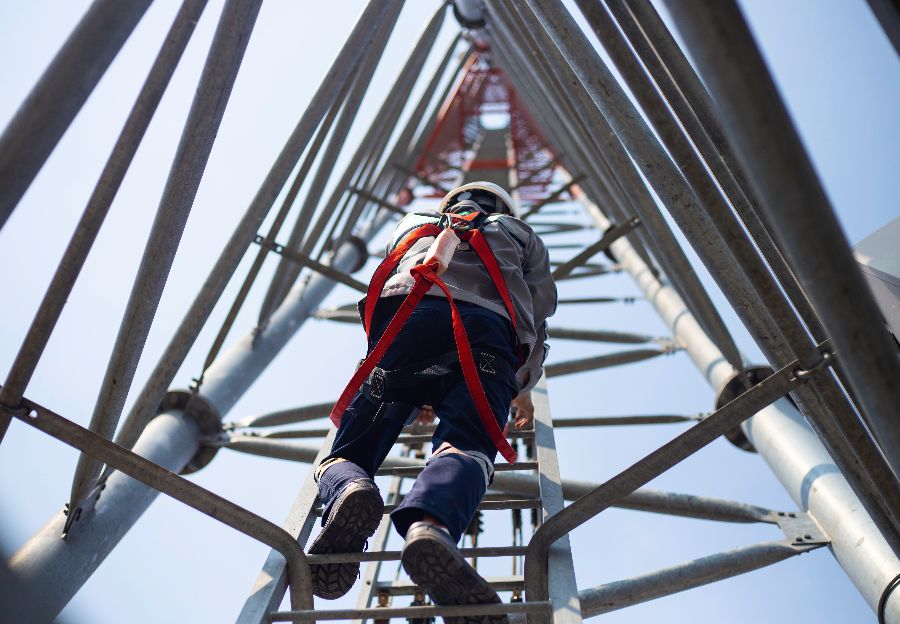Contributor: Ariana Hanaity – Communications Coordinator, VPPPA
March is National Ladder Safety Month, an annual event dedicated to promoting ladder safety and preventing ladder-related injuries and fatalities. With falls from ladders being a leading cause of workplace injuries and deaths, it’s essential for employers and workers to understand and follow the Occupational Safety and Health Administration (OSHA) regulations and best practices for ladder safety. In this post, we’ll share tips for employers and workers on how to follow OSHA’s protocols and keep workers safe, including tips for using fixed and high ladders.
Employers’ Responsibilities
As an employer, you have a responsibility to provide a safe workplace for your employees, including ensuring that the equipment they use is safe and in good working condition. Here are some additional steps you can take to help prevent ladder-related injuries when using fixed or high ladders:
1. Provide Appropriate Ladders: For tasks that require accessing heights, such as working on roofs or tall buildings, provide appropriate fixed or high ladders. Fixed ladders must meet OSHA’s standards and requirements for design, construction, and installation.
2. Conduct Regular Inspections: Regularly inspect fixed or high ladders for any damage, wear and tear, or corrosion. You must ensure that the ladders are free from defects and safe to use.
3. Install Proper Safety Features: Install proper safety features, such as cages, wells, or ladder safety devices, to prevent falls from fixed or high ladders. The use of these safety features is required by OSHA regulations.
4. Train Employees: Train your employees on the proper use of fixed or high ladders, including how to inspect them for damage, set them up properly, and use them safely. Make sure they understand the weight limits and other restrictions for each type of ladder.
5. Provide Personal Protective Equipment: Provide your employees with personal protective equipment, such as fall protection systems and harnesses, when working on fixed or high ladders. It is important to follow OSHA requirements and guidelines for selecting and using personal protective equipment.
Workers’ Responsibilities
As a worker, you also have a responsibility to follow ladder safety protocols and use the equipment provided by your employer properly. Here are some additional tips for workers on how to stay safe when using fixed or high ladders:
1. Understand the Risks: Understand the risks of working at heights and the safety procedures that you should follow when working on fixed or high ladders.
2. Use Appropriate Footwear: Wear appropriate footwear with slip-resistant soles when working on fixed or high ladders.
3. Use Proper Techniques: Use proper techniques when climbing fixed or high ladders, such as facing the ladder and using your feet, not your hands, to hold onto the rungs.
4. Secure Yourself: Secure yourself to the ladder using fall protection equipment, such as a harness, lanyard, and lifeline.
5. Report Any Issues: Report any issues with fixed or high ladders to your supervisor immediately, such as damage, wear and tear, or missing safety features.
Although the month of March spotlights Ladder Safety Month, it’s important to remember that ladder safety should be practiced year-round, as it is essential for preventing injuries and fatalities in the workplace. As an employer, it’s your responsibility to provide a safe workplace for your employees, including selecting appropriate fixed or high ladders, inspecting them regularly, installing proper safety features, training your employees, and providing personal protective equipment. As a worker, it’s your responsibility to follow ladder safety protocols and use the equipment provided by your employer properly, including understanding the risks, wearing appropriate footwear, using proper techniques, securing yourself, and reporting any issues. By working together and following these safety protocols, we can help prevent ladder-related injuries and fatalities, even when using fixed or high ladders.
References
“Ladder Safety.” Occupational Safety and Health Administration. U.S. Department of Labor. Retrieved from https://www.osha.gov/ladder-safety
“Fixed Ladders.” Occupational Safety and Health Administration. U.S. Department of Labor. Retrieved from https://www.osha.gov/fixed-ladders
“High Ladder Safety.” Industrial Safety & Hygiene News. Retrieved from https://www.ishn.com/articles/112381-high-ladder-safety
